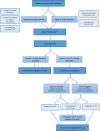Ventilator-associated pneumonia: pathobiological heterogeneity and diagnostic challenges
- PMID: 39085269
- PMCID: PMC11291905
- DOI: 10.1038/s41467-024-50805-z
Ventilator-associated pneumonia: pathobiological heterogeneity and diagnostic challenges
Abstract
Ventilator-associated pneumonia (VAP) affects up to 20% of critically ill patients and induces significant antibiotic prescription pressure, accounting for half of all antibiotic use in the ICU. VAP significantly increases hospital length of stay and healthcare costs yet is also associated with long-term morbidity and mortality. The diagnosis of VAP continues to present challenges and pitfalls for the currently available clinical, radiological and microbiological diagnostic armamentarium. Biomarkers and artificial intelligence offer an innovative potential direction for ongoing future research. In this Review, we summarise the pathobiological heterogeneity and diagnostic challenges associated with VAP.
© 2024. The Author(s).
Conflict of interest statement
The authors declare no competing interests
Figures


References
-
- Kollef, M. H. What is ventilator-associated pneumonia and why is it important? Respir. Care50, 714–721 (2005). - PubMed
Publication types
MeSH terms
Substances
LinkOut - more resources
Full Text Sources

